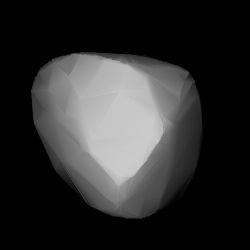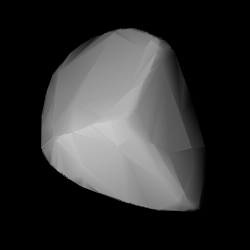Related Research Articles
997 Priska, provisional designation 1923 NR, is a carbonaceous Adeonian asteroid from the central regions of the asteroid belt, approximately 19 kilometers in diameter. It was discovered on 12 July 1923, by astronomer Karl Reinmuth at the Heidelberg-Königstuhl State Observatory in southwest Germany. The asteroid's name is a common German female name, unrelated to the discoverer's contemporaries.
Arago, provisional designation 1923 OT, is a dark asteroid from the outer regions of the asteroid belt, approximately 55 kilometers in diameter. It was discovered on 5 September 1923, by Russian astronomer Sergey Belyavsky at the Simeiz Observatory on the Crimean peninsula. The asteroid was named after French mathematician François Arago.
Lagrangea, provisional designation 1923 OU, is a carbonaceous background asteroid from the outer region of the asteroid belt, approximately 30 kilometers in diameter. It was discovered on 12 September 1923, by Russian astronomer Sergey Belyavsky at the Simeiz Observatory on the Crimean peninsula. The asteroid was named after Italian mathematician and astronomer Joseph-Louis Lagrange.
Pawlowia, provisional designation 1923 OX, is a background asteroid from the central regions of the asteroid belt, approximately 20 kilometers in diameter. It was discovered on 5 October 1923, by Soviet astronomer Vladimir Albitsky at the Simeiz Observatory on the Crimean peninsula. The asteroid was named after Russian physiologist and Nobelist Ivan Pavlov.

1073 Gellivara, provisional designation 1923 OW, is a dark Themistian asteroid, approximately 27 kilometers in diameter, located in the outer regions of the asteroid belt. It was discovered by Austrian astronomer Johann Palisa at the Vienna Observatory on 14 September 1923, and later named after the Swedish town of Gällivare.
1092 Lilium, provisional designation 1924 PN, is a dark, carbonaceous background asteroid from the outer regions of the asteroid belt, approximately 44 kilometers in diameter. It was discovered on 12 January 1924, by German astronomer Karl Reinmuth at the Heidelberg Observatory in southwest Germany. The asteroid was named after the flower Lilium.

1165 Imprinetta, provisional designation 1930 HM, is a carbonaceous Meliboean asteroid from the outer regions of the asteroid belt, approximately 49 kilometers (30 mi) in diameter. It was discovered on 24 April 1930 by Dutch astronomer Hendrik van Gent at the Union Observatory in Johannesburg, South Africa. The asteroid was named after Imprinetta Gent, wife of the discoverer.
1567 Alikoski, provisional designation 1941 HN, is a rare-type carbonaceous asteroid from the outer region of the asteroid belt, approximately 67 kilometers in diameter. It was discovered on 22 April 1941, by Finnish astronomer Yrjö Väisälä at Turku Observatory in Southwest Finland. It was later named after Finnish astronomer Heikki Alikoski.
1815 Beethoven, provisional designation 1932 CE1, is a carbonaceous background asteroid from the outer regions of the asteroid belt, approximately 30 kilometers (19 miles) in diameter. It was discovered on 27 January 1932, by German astronomer Karl Reinmuth at the Heidelberg Observatory. The uncommon F-type asteroid seems to have a long rotation period of 54 hours (tentative). It was named after Ludwig van Beethoven.

1555 Dejan, provisional designation 1941 SA, is an asteroid from the background population of the central regions of the asteroid belt, approximately 22 kilometers in diameter. It was discovered on 15 September 1941, by Belgian astronomer Fernand Rigaux at the Royal Observatory of Belgium in Uccle. The asteroid was named after Dejan Đurković, son of Serbian astronomer Petar Đurković.
1541 Estonia, provisional designation 1939 CK, is an asteroid from the central regions of the asteroid belt, approximately 21 kilometers in diameter. It was discovered on 12 February 1939, by astronomer Yrjö Väisälä at the Iso-Heikkilä Observatory near Turku, Finland. The asteroid was named after the Baltic country of Estonia.
1267 Geertruida, provisional designation 1930 HD, is a carbonaceous background asteroid from the inner regions of the asteroid belt, approximately 20 kilometers in diameter. Discovered by astronomer Hendrik van Gent at Johannesburg Observatory in 1930, the asteroid was later named after Geertruid Pels, sister of Dutch astronomer Gerrit Pels.
2012 Guo Shou-Jing, provisional designation 1964 TE2, is a carbonaceous asteroid and Florian interloper from the inner regions of the asteroid belt, approximately 13 kilometers in diameter. It was discovered on 9 October 1964, by astronomers at the Purple Mountain Observatory in Nanking, China. The asteroid was named after Chinese astronomer Guo Shoujing.
4944 Kozlovskij, provisional designation 1987 RP3, is a carbonaceous Witt asteroid from the central regions of the asteroid belt, approximately 10 kilometers (6 miles) in diameter. It was discovered on 2 September 1987, by Soviet astronomer Lyudmila Chernykh at the Crimean Astrophysical Observatory in Nauchnij, on the Crimean Peninsula. The asteroid was named for Russian opera singer Ivan Kozlovsky.
1303 Luthera, provisional designation 1928 FP, is a dark asteroid and the parent body of the Luthera family, located in the outermost regions of the asteroid belt. It measures approximately 90 kilometers in diameter. The asteroid was discovered on 16 March 1928, by astronomer Friedrich Schwassmann at the Bergedorf Observatory in Hamburg, Germany, and later named after German astronomer Robert Luther.
2043 Ortutay, provisional designation 1936 TH, is a dark asteroid from the outer regions of the asteroid belt, approximately 45 kilometers in diameter. The asteroid was discovered by Hungarian astronomer György Kulin at the Konkoly Observatory, Budapest, on 12 November 1936. It was named after Hungarian ethnographer Gyula Ortutay.
4176 Sudek, provisional designation 1987 DS, is a Themistian asteroid from the outer regions of the asteroid belt, approximately 17 kilometers in diameter. It was discovered on 24 February 1987, by Czech astronomer Antonín Mrkos at the Kleť Observatory in the Czech Republic. The presumed C-type asteroid has a rotation period of 8.16 hours. It was named in memory of Czech photographer Josef Sudek.
2169 Taiwan, provisional designation 1964 VP1, is a carbonaceous Astridian asteroid from the central regions of the asteroid belt, approximately 17 kilometers in diameter. It was discovered on 9 November 1964, by astronomers at the Purple Mountain Observatory near Nanking, China. It was named for Taiwan.
1323 Tugela, provisional designation 1934 LD, is a dark background asteroid from the outer regions of the asteroid belt, approximately 60 kilometers in diameter. It was discovered on 19 May 1934, by South African astronomer Cyril Jackson at the Union Observatory in Johannesburg. The asteroid was named for the Tugela River in western South Africa.
1302 Werra, provisional designation 1924 SV, is a Themistian asteroid from the outer regions of the asteroid belt, approximately 30 kilometers in diameter. It was discovered on 28 September 1924, by German astronomer Karl Reinmuth at the Heidelberg-Königstuhl State Observatory. The asteroid was named for the river Werra in central Germany.
References
- 1 2 3 4 "JPL Small-Body Database Browser: 2127 Tanya (1971 KB1)" (2017-06-05 last obs.). Jet Propulsion Laboratory . Retrieved 3 July 2017.
- 1 2 3 Schmadel, Lutz D. (2007). "(2127) Tanya". Dictionary of Minor Planet Names – (2127) Tanya. Springer Berlin Heidelberg. p. 172. doi:10.1007/978-3-540-29925-7_2128. ISBN 978-3-540-00238-3.
- 1 2 3 4 5 6 "LCDB Data for (2127) Tanya". Asteroid Lightcurve Database (LCDB). Retrieved 27 March 2017.
- 1 2 3 Masiero, Joseph R.; Grav, T.; Mainzer, A. K.; Nugent, C. R.; Bauer, J. M.; Stevenson, R.; et al. (August 2014). "Main-belt Asteroids with WISE/NEOWISE: Near-infrared Albedos". The Astrophysical Journal. 791 (2): 11. arXiv: 1406.6645 . Bibcode:2014ApJ...791..121M. doi:10.1088/0004-637X/791/2/121. S2CID 119293330 . Retrieved 27 March 2017.
- 1 2 3 4 Mainzer, A.; Grav, T.; Masiero, J.; Hand, E.; Bauer, J.; Tholen, D.; et al. (November 2011). "NEOWISE Studies of Spectrophotometrically Classified Asteroids: Preliminary Results". The Astrophysical Journal. 741 (2): 25. arXiv: 1109.6407 . Bibcode:2011ApJ...741...90M. doi:10.1088/0004-637X/741/2/90. S2CID 35447010.
- 1 2 3 4 Usui, Fumihiko; Kuroda, Daisuke; Müller, Thomas G.; Hasegawa, Sunao; Ishiguro, Masateru; Ootsubo, Takafumi; et al. (October 2011). "Asteroid Catalog Using Akari: AKARI/IRC Mid-Infrared Asteroid Survey". Publications of the Astronomical Society of Japan. 63 (5): 1117–1138. Bibcode:2011PASJ...63.1117U. doi: 10.1093/pasj/63.5.1117 . (online, AcuA catalog p. 153)
- 1 2 3 4 Nugent, C. R.; Mainzer, A.; Bauer, J.; Cutri, R. M.; Kramer, E. A.; Grav, T.; et al. (September 2016). "NEOWISE Reactivation Mission Year Two: Asteroid Diameters and Albedos". The Astronomical Journal. 152 (3): 12. arXiv: 1606.08923 . Bibcode:2016AJ....152...63N. doi: 10.3847/0004-6256/152/3/63 .
- 1 2 3 4 Nugent, C. R.; Mainzer, A.; Masiero, J.; Bauer, J.; Cutri, R. M.; Grav, T.; et al. (December 2015). "NEOWISE Reactivation Mission Year One: Preliminary Asteroid Diameters and Albedos". The Astrophysical Journal. 814 (2): 13. arXiv: 1509.02522 . Bibcode:2015ApJ...814..117N. doi:10.1088/0004-637X/814/2/117 . Retrieved 27 March 2017.
- 1 2 3 Waszczak, Adam; Chang, Chan-Kao; Ofek, Eran O.; Laher, Russ; Masci, Frank; Levitan, David; et al. (September 2015). "Asteroid Light Curves from the Palomar Transient Factory Survey: Rotation Periods and Phase Functions from Sparse Photometry". The Astronomical Journal. 150 (3): 35. arXiv: 1504.04041 . Bibcode:2015AJ....150...75W. doi:10.1088/0004-6256/150/3/75. S2CID 8342929 . Retrieved 27 March 2017.
- 1 2 Veres, Peter; Jedicke, Robert; Fitzsimmons, Alan; Denneau, Larry; Granvik, Mikael; Bolin, Bryce; et al. (November 2015). "Absolute magnitudes and slope parameters for 250,000 asteroids observed by Pan-STARRS PS1 - Preliminary results". Icarus. 261: 34–47. arXiv: 1506.00762 . Bibcode:2015Icar..261...34V. doi:10.1016/j.icarus.2015.08.007. S2CID 53493339 . Retrieved 27 March 2017.
- 1 2 "2127 Tanya (1971 KB1)". Minor Planet Center. Retrieved 27 March 2017.
- ↑ "MPC/MPO/MPS Archive". Minor Planet Center. Retrieved 27 March 2017.